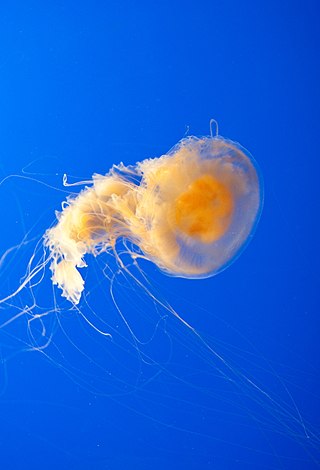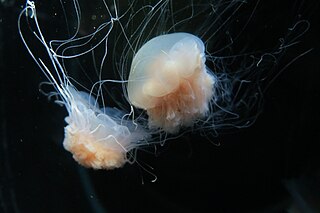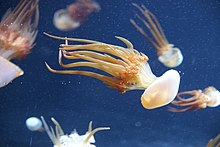
Jellyfish, also known sea jellies, are the medusa-phase of certain gelatinous members of the subphylum Medusozoa, which is a major part of the phylum Cnidaria.

The Yellow Sea is a marginal sea of the Western Pacific Ocean located between mainland China and the Korean Peninsula, and can be considered the northwestern part of the East China Sea. It is one of four seas named after common colour terms, and its name is descriptive of the golden-yellow color of the silt-ridden water discharged from major rivers.

Nomura's jellyfish is a very large rhizostome jellyfish, in the same size class as the lion's mane jellyfish, the largest cnidarian in the world. It is edible but not considered high quality. It is the only species in the monotypic genus Nemopilema.

Pelagia noctiluca is a jellyfish in the family Pelagiidae and the only currently recognized species in the genus Pelagia. It is typically known in English as the mauve stinger, but other common names are purple-striped jelly, purple stinger, purple people eater, purple jellyfish, luminous jellyfish and night-light jellyfish. In Greek, pelagia means "(she) of the sea", from pelagos "sea, open sea"; in Latin noctiluca is the combining form of nox, "night"", and lux, "light"; thus, Pelagia noctiluca can be described as a marine organism with the ability to glow in the dark (bioluminescence). It is found worldwide in tropical and warm temperate seas, although it is suspected that records outside the North Atlantic region, which includes the Mediterranean and Gulf of Mexico, represent closely related but currently unrecognized species.

Phacellophora camtschatica, commonly known as the fried egg jellyfish or egg-yolk jellyfish, is a very large jellyfish in the family Phacellophoridae. This species can be easily identified by the yellow coloration in the center of its body which closely resembles an egg yolk, hence how it got its common name. Some individuals can have a bell close to 60 cm (2 ft) in diameter, and most individuals have 16 clusters of up to a few dozen tentacles, each up to 6 m (20 ft) long. A smaller jellyfish, Cotylorhiza tuberculata, typically found in warmer water, particularly in the Mediterranean Sea, is also popularly called a fried egg jellyfish. Also, P. camtschatica is sometimes confused with the Lion's mane jellyfish.

Phyllorhiza punctata is a species of jellyfish, also known as the floating bell, Australian spotted jellyfish, brown jellyfish or the white-spotted jellyfish. It is native to the western Pacific from Australia to Japan, but has been introduced widely elsewhere. It feeds primarily on zooplankton. P. punctata generally can reach up to 50 centimetres (20 in) in bell diameter, but in October 2007, one 72 cm (28 in) wide, perhaps the largest ever recorded, was found on Sunset Beach, North Carolina.

The black sea nettle, sometimes informally known as the black jellyfish, is a species of jellyfish that can be found in the waters of the Pacific Ocean off North America. Its range is thought to be from Monterey Bay in the north, down to southern Baja California and Mexico, though there are reports of sightings as far north as British Columbia. The initial acknowledgment of the species occurred in 1997, after large groups were found on the Pacific coast.

Chrysaora hysoscella, the compass jellyfish, is a common species of jellyfish that inhabits coastal waters in temperate regions of the northeastern Atlantic Ocean, including the North Sea and Mediterranean Sea. In the past it was also recorded in the southeastern Atlantic, including South Africa, but this was caused by confusion with close relatives; C. africana, C. fulgida and an undescribed species tentatively referred to as "C. agulhensis".

Cyanea is a genus of jellyfish, primarily found in northern waters of the Atlantic and Pacific Oceans and southern Pacific waters of Australia and New Zealand, there are also several boreal, polar, tropical and sub-tropical species. Commonly found in and associated with rivers and fjords. The same genus name has been given to a genus of plants of the Hawaiian lobelioids, an example of a parahomonym.

Sea cucumber stocks have been overexploited in the wild, resulting in incentives to grow them by aquaculture. Aquaculture means the sea cucumbers are farmed in contained areas where they can be cultured in a controlled manner. In China, sea cucumbers are cultured, along with prawns and some fish species, in integrated multi-trophic systems. In these systems, the sea cucumbers feed on the waste and feces from the other species. In this manner, what would otherwise be polluting byproducts from the culture of the other species become a valuable resource that is turned into a marketable product.

The harvesting and consuming of seafoods are ancient practices that may date back to at least the Upper Paleolithic period which dates to between 50,000 and 10,000 years ago. Isotopic analysis of the skeletal remains of Tianyuan man, a 40,000-year-old modern human from eastern Asia, has shown that he regularly consumed freshwater fish. Archaeology features such as shell middens, discarded fish bones and cave paintings show that sea foods were important for survival and consumed in significant quantities. During this period, most people lived a hunter-gatherer lifestyle and were, of necessity, constantly on the move. However, where there are early examples of permanent settlements such as those at Lepenski Vir, they are almost always associated with fishing as a major source of food.

Cyanea nozakii or Cyanea nozaki (misspelling), commonly known as the ghost jellyfish, is a species of jellyfish found in the northern Pacific Ocean near the coasts of China and Japan. Along with other species of large jellyfish, it is showing a greater tendency to appear in large numbers and cause blooms.

Some species of jellyfish are suitable for human consumption and are used as a source of food and as an ingredient in various dishes. Edible jellyfish is a seafood that is harvested and consumed in several East and Southeast Asian countries, and in some Asian countries it is considered to be a delicacy. Edible jellyfish is often processed into a dried product. Several types of foods and dishes may be prepared with edible jellyfish, including salads, sushi, noodles, and main courses. Various preparation methods exist.

Sanderia malayensis is a species of jellyfish in the family Pelagiidae, native to the tropical Indo-Pacific. It has a complex life cycle and is thought to be venomous and to have caused injuries to humans.

The South American sea nettle is a species of jellyfish from the family Pelagiidae. It is found from the Pacific coast of Peru, south along Chile's coast to Tierra del Fuego, and north along the Atlantic coast of Argentina, with a few records from Uruguay. Despite its common name, it is not the only sea nettle in South America. For example, C. lactea is another type of sea nettle in this region. Historically, C. plocamia was often confused with C. hysoscella, a species now known to be restricted to the northeast Atlantic. C. plocamia is a large jellyfish, up to 1 m in bell diameter, although most mature individuals only are 25–40 cm (10–16 in).

Jellyfish blooms are substantial growths in population of species under the phyla Cnidaria and Ctenophora.

Cephea cephea, also known as the crown jellyfish, or cauliflower jellyfish, is a species of jellyfish in the family Cepheidae. It occurs in the tropical waters of the western Indo-Pacific to Northern Australia. The species was first described by Peter Forsskål in 1775 and originally given the name Medusa cephea. It inhabits the pelagic zone of tropical and sub-tropical waters and is most commonly found in the Indo-West Pacific, eastern Atlantic and the Red Sea. Although this species is among the most venomous jellyfish, it is not harmful to humans and is eaten as a delicacy and used for medical purposes in China and Japan. The species can achieve a diameter of up to 60 cm.

Aurelia coerulea or Asian moon jelly is a species of moon jelly in the genus Aurelia. This species is native to the seas off Japan, China, Korea, and California, as well as the Mediterranean and other temperate seas. and they can also be found in coastal areas of China, Korea, California, the Mediterranean and other temperate seas. It is particularly abundant in artificial habitats and sheltered regions. It has a very high reproductive rate which can cause blooming events. A.coerulea blooming causes problems such as impairing fisheries, clogging the nuclear power plants and disrupting the local zooplankton abundance. The chemical compounds the species secretes as a self-defense mechanism can be used for pharmaceutical purposes.

Acromitus flagellatus is a species of jellyfish in the Catostylidae family, suborder Dactyliophorae. It was discovered in 1903 by Otto Maas in the Malay Archipelago, and is closely related to Nemopilema nomurai and Rhopilema esculentum Other species in the genus Acromitus include A. hardenbergi,A. maculosus,A. rabanchatu, and A. tankahkeei.A. flagellatus get their name from their long flagellum and their oral arms that are as about as long as the diameter of their bell, while other species in the genus, like A. hardenbergi, have oral arms that are about half the length of their bell.



















